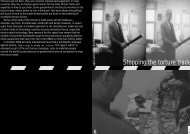CROWD CONTROL TECHNOLOGIES - Omega Research Foundation
CROWD CONTROL TECHNOLOGIES - Omega Research Foundation
CROWD CONTROL TECHNOLOGIES - Omega Research Foundation
Create successful ePaper yourself
Turn your PDF publications into a flip-book with our unique Google optimized e-Paper software.
devices. 28 What follows is a brief account of the lines of research that have produced todays chemical<br />
irritant, kinetic energy and electro-shock weapons.<br />
2.1 Chemical Crowd Control Weapons - Design & Effects. Disabling chemical weapons used for<br />
law enforcement consist of a disabling chemical and a dispersion mechanism. There are inherent<br />
difficulties inevitable in marrying a chemical which has high effectiveness at very low doses with the<br />
requirement of low toxicity. Intensive work began in the 1950's, particularly in the USA and the UK, who<br />
shared their information on Chemical & Biological Weapons (CBW). In 1956, the UK War Office<br />
established the need for a chemical weapon able to drive back )fanatical rioters( which led to the<br />
adoption of CS, (then code numbered T792) for use in the colonies of Cyprus and British Guyana. In<br />
1958, a Task Group on CBW was set up in the USA. The US Chemical Corps recommended two CW<br />
agents for consideration, namely CS and the vomiting agent DM, whilst describing mustard gas as<br />
)primarily a non-lethal agent.( 29 Work also began on searching for chemical incapacitants )particularly<br />
non-lethal persistent chemical agents that are capable of attacking through the skin and can produce<br />
incapacitation for one to three weeks.( 30<br />
Nowadays, the Chemical Weapons Convention permits the use of tear gas and other toxic<br />
temporarily disabling chemicals and their precursors for law enforcement and domestic riot control<br />
purposes (which it does not define) as long as the chemicals listed in Schedule 1 of the convention are<br />
not used. 31 This provision rules out DM, which is a toxic arsenic based substance previously held by<br />
certain countries outside the EU, including South Africa, which secretly explored the use of MDMA<br />
(Ecstasy) as a crowd control incapacitant. 32<br />
2.1.1 Disabling Chemical Irritant and Harassing Agents. By the 1970's, 15 different chemicals with<br />
sensory irritant properties had been reported for use in civil disturbances. 33 However, despite intensive<br />
research, 34 only four chemicals are commonly used for crowd control purposes, namely CN (1chloroacetophenone),<br />
CS (2-chlorobenzylidene malononitrile), CR (dibenz (b:f)-1:4 oxazepine), and OC<br />
(Oleoresin Capsicum). Until recently, the two former agents were the ones most likely to be found in<br />
European police arsenals but increasingly European security forces are introducing OC. Whilst CR is<br />
usually a special forces weapon, although one company in India has packaged it for crowd control<br />
operations. 35 In the Nineties, various US companies started to aggressively promote the use of<br />
Oleoresin Capsicum (OC) - a plant toxin extract derived from hot chilli peppers and therefore popularly<br />
known as pepper-gas and later a more standardized synthetic variant emerged, known as PAVA<br />
(Pelargonic Acid Vanillyamide). 36<br />
CN was first prepared by Graebe in 1871 and like most so called tear gas weapons is a solid<br />
which becomes a fine mist of particles when distributed. Thus technically speaking, the riot control<br />
agents are not gases but aerosols. In concentrations of about 10 mg/m 3 it produces burning or stinging<br />
sensations in the throat, eyes and nose accompanied by excess salivation and profuse crying. It also<br />
causes exposed skin to sting and constricting sensations in the chest. In high concentrations this riot<br />
agent kills. It has a very low vapour pressure and is therefore persistent, contaminating room areas,<br />
vehicles, clothing and furniture all of which will require decontamination if untoward biomedical<br />
implications are to be avoided.<br />
CS was first synthesized in the US by Corson and Stoughton in 1928 and is up to 5 times more<br />
potent than CN (based on the concentration per cubic metre that would be intolerable to 50% of an<br />
exposed population (ICt50) see Table 1), with marked harassment at concentrations of 4mg/m 3 . CS<br />
causes a burning sensation in the eyes which may be severe enough to precipitate involuntary eye<br />
closure (blepharospasm). It also produces severe irritation of the respiratory tract, burning pain in the<br />
nose, sneezing, soreness and tightness of the chest with coughing bouts following initial exposure and<br />
is a primary irritant of the skin. Even very light exposures can cause a rapid rise in blood pressure and<br />
as this increases, these effects become more intense with gagging, nausea and vomiting. A temporary<br />
fear of light, or photophobia is an associated side effect which occurs in roughly 10% of the people<br />
exposed.<br />
xxi




